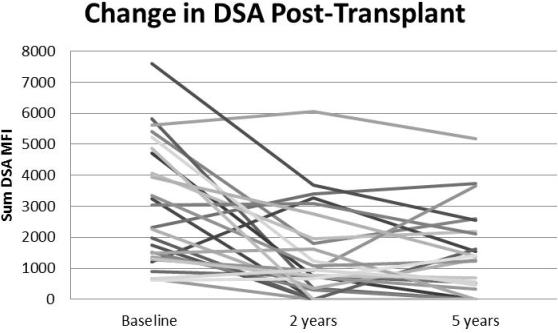Baseline Donor Specific Antibody (DSA) More Predictive of Chronic Antibody Mediated Rejection (CAMR) Than the Change in DSA Over Time.
1Division of Nephrology and Hypertension, Mayo Clinic, Rochester, MN
2Division of Transfusion Medicine, Mayo Clinic, Rochester, MN.
Meeting: 2016 American Transplant Congress
Abstract number: C22
Keywords: Antibodies, HLA antibodies, Kidney transplantation, Protocol biopsy
Session Information
Session Name: Poster Session C: Antibody Mediated Rejection: Session #1
Session Type: Poster Session
Date: Monday, June 13, 2016
Session Time: 6:00pm-7:00pm
 Presentation Time: 6:00pm-7:00pm
Presentation Time: 6:00pm-7:00pm
Location: Halls C&D
Introduction: Although therapies are available to at least temporarily reduce DSA, the change in DSA naturally post-transplant remains unknown. We aim to study the serial change in DSA in patients with pre-transplant DSA and correlate with CAMR.
Methods: From 10/2007 and 5/2014, all patients with baseline DSA Mean Fluorescence Intensity (MFI) >1000 or crossmatch were studied. DSA was measured at baseline, 2, and 5 years post-transplant. The baseline and change in DSA was correlated with renal histology. A change in MFI was considered a 50% increase, 50% decrease, or complete disappearance of the sum DSA MFI per patient. Protocol biopsies were performed at 1, 2, and 5 years post-transplant and scored by Banff 2013.
Results: 132 patients with DSA were studied (40.6% negative and 58.6% positive B flow crossmatch). 25.6% (34/132) patients received antibody depleting therapy after baseline DSA obtained. At 2 and 5 years, DSA was available for 80.0% (105/132) and 28.8% (38/132) of patients, respectively. The sum MFI at baseline was associated with the development of Transplant Glomerulopathy (TG) [HR 1.5(CI 1.2-1.8)] p<0.001 over mean follow-up of 4.1+/-1.8 years. De novo DSA appeared in 7.6% (10/132) of patients. At 2 years, the sum DSA MFI decreased or disappeared in 63.0% (66/104) of patients. This was similar at 5 years 62.1% (23/37). Previous antibody depleting therapy did not affect results (p=0.84). A 50% or greater reduction in sum DSA MFI was not associated with reduced CAMR (p=0.89).
Conclusions: Most DSA decreases within the first 2 years post-transplant even without therapy. Patients with a reduction or complete disappearance of DSA by 2 years post-transplant do not appear to have reduced CAMR. However, the baseline sum DSA MFI is associated with the development of CAMR. This finding has important implications for the study of future antibody depleting therapy because reduction in DSA alone may not be effective in reducing the risk for CAMR. 
CITATION INFORMATION: Mitema D, Cheungpasitporn W, Stegall M, Cosio F, Gandhi M, Schinstock C. Baseline Donor Specific Antibody (DSA) More Predictive of Chronic Antibody Mediated Rejection (CAMR) Than the Change in DSA Over Time. Am J Transplant. 2016;16 (suppl 3).
To cite this abstract in AMA style:
Mitema D, Cheungpasitporn W, Stegall M, Cosio F, Gandhi M, Schinstock C. Baseline Donor Specific Antibody (DSA) More Predictive of Chronic Antibody Mediated Rejection (CAMR) Than the Change in DSA Over Time. [abstract]. Am J Transplant. 2016; 16 (suppl 3). https://atcmeetingabstracts.com/abstract/baseline-donor-specific-antibody-dsa-more-predictive-of-chronic-antibody-mediated-rejection-camr-than-the-change-in-dsa-over-time/. Accessed December 20, 2025.« Back to 2016 American Transplant Congress
